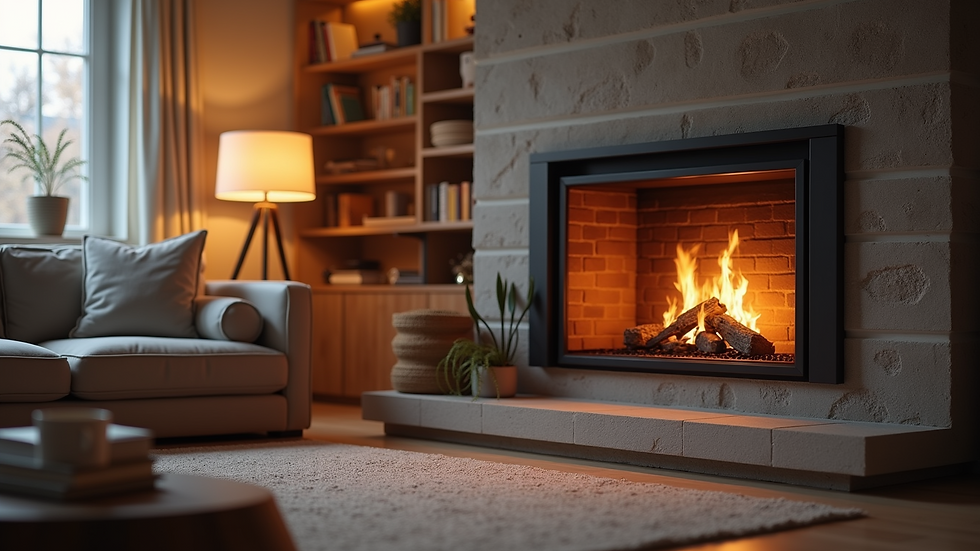Understanding ODS Letters for Safe Gas Fireplaces and Oxygen-Depletion Sensors
- Oct 21
- 3 min read
Gas fireplaces and oxygen-depletion sensors are vital for comfort in many homes, especially during colder months. However, ensuring their safe operation is crucial for everyone’s health and safety. This is where ODS letters come into play. These letters are necessary for some lenders as they verify that gas appliances operate safely. In this blog post, we will explore the significance of ODS letters and how they enhance gas safety in homes.
What is an ODS Letter?
An ODS letter, or Oxygen Depletion Sensor letter, certifies the safe operation of gas appliances, focusing on gas fireplaces and oxygen-depletion sensors. Lenders often request this letter during the home buying process to confirm the property meets safety standards. For instance, if you are buying a home equipped with a gas fireplace, having an ODS letter can reassure you that the appliance has been checked for safe operation, significantly lowering the risk of carbon monoxide poisoning, which affects around 20,000 people in the U.S. annually.
The Importance of Gas Safety
Gas safety is a top priority for homeowners and renters. Gas appliances, though convenient, can pose serious risks if improperly maintained. Carbon monoxide (CO) poisoning is a primary concern, especially since CO is colorless and odorless. According to the CDC, there are over 400 accidental CO poisoning deaths each year in the U.S.
Oxygen-depletion sensors detect low oxygen levels and shut off the gas supply to prevent dangerous situations. Keeping these sensors in good working order is essential for household safety. An ODS letter provides evidence that these important safety measures are in place and functioning.
How ODS Letters are Obtained
To obtain an ODS letter, homeowners must have their gas appliances inspected by certified professionals. Technicians will evaluate the gas fireplace and oxygen-depletion sensors, ensuring they meet safety criteria. For instance, during a typical inspection, tasks may include checking gas lines for leaks and verifying that ventilation systems are clear and functional.
When inspections conclude with everything deemed safe, the technician issues an ODS letter. Homeowners can then present this documentation to lenders or insurance companies as proof of compliance with safety regulations.
Who Needs an ODS Letter?
While not every homeowner is required to secure an ODS letter, it is essential for those pursuing a mortgage or insurance. Many lenders will request ODS documentation to ensure safe properties. For example, when applying for a mortgage, nearly 38% of lenders check for safety compliance in homes with gas appliances. Furthermore, sellers might need to provide an ODS letter to potential buyers to demonstrate the home is safe and well-maintained.
Benefits of Having an ODS Letter
Peace of Mind: Homeowners gain assurance knowing their gas appliances have been professionally inspected and certified safe.
Increased Property Value: An ODS letter can enhance property value by indicating ongoing maintenance and safety compliance, which can attract more buyers.
Insurance Compliance: Many insurance providers require proof of safe gas appliance operation to issue a policy, making an ODS letter essential for homeowners.
Safety Assurance: Regular inspections and ODS letters ensure that gas appliances function properly, reducing accident and health hazard risks significantly.
Common Misconceptions About ODS Letters
Many homeowners have misconceptions about ODS letters, which can cause confusion. One common belief is that an ODS letter is only for older homes. In reality, any home with gas appliances should consider this certification.
Another myth is that ODS letters are only needed during the home buying process. While often requested then, homeowners should aim to obtain an ODS letter as part of regular maintenance, ensuring safety at all times.
Maintaining Gas Appliances for Safety
Beyond obtaining an ODS letter, homeowners should take proactive steps to maintain their gas appliances. The following recommendations can help ensure safe operation:
Schedule Regular Inspections: Aim for annual evaluations by certified technicians to check gas appliances and sensors for safe functionality.
Ensure Proper Ventilation: Make sure gas appliances have adequate ventilation to minimize the risk of harmful gas buildup.
Monitor for Malfunctions: Stay aware of any unusual odors, sounds, or performance issues and address them immediately.
Install Carbon Monoxide Detectors: In addition to oxygen-depletion sensors, having carbon monoxide detectors in your home can provide an extra layer of safety.

Final Thoughts
ODS letters are crucial for ensuring the safety of gas fireplaces and oxygen-depletion sensors. By confirming that these appliances work safely, ODS letters provide peace of mind and facilitate compliance for lenders and insurance firms. Regular inspections and maintenance should be priorities for homeowners with gas appliances. Understanding the significance of ODS letters and practicing preventive measures can create a secure and comfortable living space for all family members.





